Shep Hyken's Blog, page 160
October 11, 2017
Invent Your Vocabulary to Emphasize Who You Are
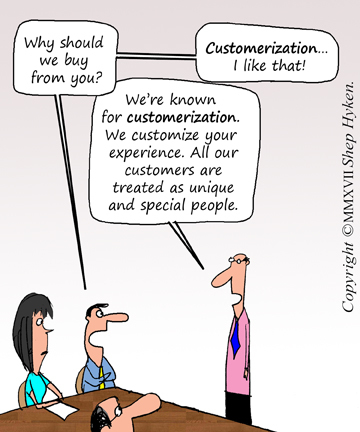 The other night I was on a Southwest Airlines flight, traveling home from a speaking engagement. While waiting to board, I noticed a sign advertising Southwest’s concept they call “transfarency.”
The other night I was on a Southwest Airlines flight, traveling home from a speaking engagement. While waiting to board, I noticed a sign advertising Southwest’s concept they call “transfarency.”
The sign read as follows:
Transfarency [Trans-fair-uhn-see] n.
Philosophy created by Southwest Airlines in which Customers are treated honestly and fairly, and low fares actually stay low – no unexpected bag fees, change fees, or hidden fees. Created and practiced exclusively by Southwest Airlines.
Yes to low fares with nothing to hide. That’s Transfarency.
In the past, I’ve written about the concept of how changing vocabulary can help shift an attitude and even a company’s culture. But, inventing words takes the vocabulary concept to a new level. Southwest Airlines has always promised to be a low fare airline. They give away peanuts, not meals, and they are proud of it. They don’t “nickel and dime” customers with extra fees, and they’ve used that point to differentiate themselves from their competitors. And, now they invented a word to describe it, transfarency.
There is a word to describe what Southwest has done. It is portmanteaus. It is combining words and sounds from two or more other words. It can be clever, yet at the same time it can make a point. Southwest’s use of the two words, transparency and fare, align with their brand promise and is part of their customer experience.
Robitussin, the popular cough syrup came up with a campaign a few years ago to emphasize the results of using their product: “Don’t suffer the cough-equences!” That’s a successful way of defining what they want their customers to experience.
Sometimes it’s not about combining two words, but making words up. I remember the Volkswagen campaign in the 1990’s where they used two German words, fahren and vergnugen, to create fahrvergnugen (pronounced far-fair-gnu-ghen), to describe the driving experience. Roughly translated, the word means driving pleasure. That’s what VW wants every customer to experience when driving one of their cars. It’s a brand promise.
Another made up word is WBYCEIYDBO, which is actually an acronym that CarMax came up with that means, “We’ll buy your car even if you don’t buy ours.” The word or phrase emphasizes they are friendly, flexible, and easy. And, the commercials are fun. They’ve created a strong message about their version of customer experience.
There are plenty of examples that can be found with a little Internet research. The point of all of this is to get you to think of an interesting, and even fun, way to describe what you do for your customers and what you want them to experience.
Shep Hyken is a customer service expert, keynote speaker, and New York Times bestselling business author. For information, contact 314-692-2200 or www.hyken.com. For information on The Customer Focus™ customer service training programs, go to www.thecustomerfocus.com. Follow on Twitter: @Hyken
(Copyright © MMXVII, Shep Hyken)
The post Invent Your Vocabulary to Emphasize Who You Are appeared first on Shep Hyken.
October 10, 2017
Amazing Business Radio: Daniel Burrus
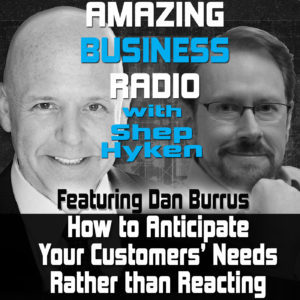
Daniel Burrus Shares How to Anticipate Your Customers’ Needs Rather than Reacting
How would you like to be able to anticipate your customers’ needs before the even ask?
Shep Hyken interviews Daniel Burrus, author of The Anticipatory Organization: Turn Disruption and Change Into Opportunity and Advantage, in which he explains how to predict what customers need rather than simply waiting to be asked.
They discuss understanding the difference between anticipatory customer service and reactionary customer service. Daniel shares with listeners the importance of being able to predict problems before they occur, and how to predict game-changing opportunities to redefine and reinvent customer service.
Top Takeaways:
Know the difference between assumption and fact.
Look at the big problems like you would an onion, and peel back the layers until you get to the core.
Anticipating doesn’t have to be based on a feeling. It can be based on fact.
Two types of trends to help you anticipate:
Hard trends – based on future facts. These can’t be stopped.
Soft trends – based on assumption. These can be changed.
Look at the hard trends and look to create opportunities based on facts.
Predict where your customer is going so that you can meet them at the next intersection.
About:
Daniel Burrus is not only the author of The Anticipatory Organization: Turn Disruption and Change Into Opportunity and Advantage he is also considered one of the World’s Leading Futurists on Global Trends and Innovation. The New York Times has referred to him as one of the top three business gurus in the highest demand as a speaker.
Shep Hyken is a customer service and experience expert , “New York Times” best-selling author, award-winning keynote speaker , and your host of Amazing Business Radio.
“Stop looking at today, because today looks more like yesterday than tomorrow.” – Daniel Burrus
This episode of Amazing Business Radio with Shep Hyken answers the following questions … and more:
How can I anticipate my customers’ needs?
How can I predict problems before they occur?
How can I create opportunities based on facts?
The post Amazing Business Radio: Daniel Burrus appeared first on Shep Hyken.
October 9, 2017
5 Top Customer Service Articles for the Week of October 9, 2017
Each week I read a number of customer service articles from various online resources. Here are my top five picks from last week. I have added my comment about each article and would like to hear what you think too.
Netflix Sent the Best Cease-and-Desist Letter to This Unauthorized Stranger Things Bar by Tim Nudd
(Adweek) Netflix seemingly can do no wrong when it comes to its marketing. Even its cease-and-desist letters are creative enough to get glowing reviews.
My Comment: There’s an old expression: You will catch more flies with honey than with vinegar. When a major corporation has to send a “cease-and-desist” letter, it’s usually ugly and threatening. Not if your Netflix. They care about their customers. And, from the story in this article, they give their customers a chance to make things right with dignity and respect. While not typical customer service, this shows you how a company knows how to treat their customers, even when they are wrong.
Does CX fail because of design, culture, strategy, or … the “Q-word?” by Ricardo Saltz
(Eglobalis) Companies are shooting themselves in the foot consistently around their customer experience. Why? And how do we help them to make it better?
My Comment: The author starts the article with a great (Tweetable) quote: Quality is the main pillar of any product and service is the main pillar of a great customer experience. In other words, no matter how good the experience is, if the product doesn’t do what it’s supposed to do, the customer will move on. And, no matter how good the product is, if the customer is treated poorly, he/she will move on. It takes both.
How to Build a Happier, More Motivated Front-Line Team by StellaService
(StellaService) In this eBook for customer service team leaders, we explain the difficulties front-line employees face, the true business costs of low morale, and what it will take to turn the tide and build a working environment that inspires greatness.
My Comment: I’m a big fan of Stella Service and what they do. I refer to them as the consumer reports of the customer service industry. They just released an eBook about motivating your frontline team. You’ll have to share your name and email, but it worth it. And if you’re not already following and getting info from StellaService, you should be.
When Customer Experience Fails, Service Management To The Rescue! by Paul Selby
(CustomerThink) The CRM approach to customer service is to take the call, email, or chat; answer the question and document it; then move on to the next (perhaps identical) customer issue. Service management is better suited to improve the customer experience because unlike CRM, it’s about bringing the right resources to bear on solving an underlying issue so that it doesn’t recur.
My Comment: This article starts with a quote from Charlie Herrin, EVP of customer experience at Comcast: “Customer service is what happens when the experience breaks.” That grabbed me. While I think there is more to customer service than fixing what’s broken, I like that way of thinking. Customer service people can step in and fix problems and save customers. The author shares some good points about doing exactly that.
Treat Every Customer Like Your Grandad by Paul Pember
(LinkedIn) I’m currently leading on creating an organization-wide customer experience strategy for my current employers, Southern Housing Group. I’ve spent the last few months contemplating my approach, thinking about what strategy actually means and the outcomes I hope to achieve from it. For me, the starting point is always blue-sky or what is the perfect world scenario, which led me to the question, what does customer service excellence look and feel like?
My Comment: Here’s a great concept. Treat your customers with the respect and care as you would a close family member – like your Granddad. The author shares how his father noticed an employee treating her Granddad differently than other customers, which led him to ask, “Why can’t she treat all customers like that?”
Shep Hyken is a customer serv ice expert, professional speaker and New York Times bestselling business author. For information contact (314)692-2200 or www.hyken.com . For information on The Customer Focus™ customer service training programs go to www.thecustomerfocus.com . Follow on Twitter: @Hyken
The post 5 Top Customer Service Articles for the Week of October 9, 2017 appeared first on Shep Hyken.
October 6, 2017
Guest Blog: 4 Tricks for Keeping Your Cool in Tricky Service Situations
This week we feature an article by Pascal van Opzeeland that discusses how to handle difficult customers. Most of the time we encounter tricky service situations, we want to resolve them and restore the customer’s confidence in doing business with us. – Shep Hyken
When you’re working in customer service, difficult customers are a part of your job. I’m not just talking about the occasional angry customer . Some customers will show racism, sexism, others might even try to hit on you.
My colleague Sven covered these challenges in “The 7 Hardest Customer Service Scenarios Without Easy Answers.” But how do you keep your professional cool in such situations? Here are four mind tricks that can help you out.
Circles of Control
This tip originates from stoicism, the ancient Greek school of philosophy founded in Athens that flourished throughout the classical world until the 3rd century AD. These days it’s popular among all ranges of high performers – top athletes, Hollywood actors, Silicon Valley CEOs, etc.
[Stoicism] helps us overcome destructive emotions and act on what can be acted upon. […] it’s built for action, not endless debate. – Ryan Holiday
It’s so popular because it’s easily applicable in high-stress environments. More than a grand philosophy, stoicism is a set of reminders we can hold on to throughout difficult situations – like when a customer is yelling at you. It’s a step-by-step system for overcoming fear and doubt.
The circles of control form an important insight of stoicism. We can only control our thoughts and our actions (internal circle). All else is outside of our control. Yet we all worry about events outside of our control (external circle). Traffic, our health, the mood of our spouse, the weather.
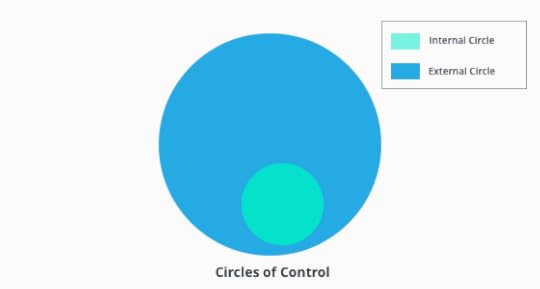
The Stoics argue that you should only focus your attention on what’s inside of your control. How a customer treats you is outside of your control. All that matters is how you respond.
When you’re thrown into an intense customer encounter, remind yourself of these circles of control. Realize that you can only pull the levers present within your circle; don’t worry about what’s outside.
It takes some practice to reach this mindset, but once you have, you’ll feel peace and tranquility throughout your workday. If you wish to dive deeper into stoicism, I recommend the books The Daily Stoic and The Obstacle is the Way.
Mindfulness
From ancient Greece, we hop over to ancient India, the birth ground of Buddhism and mindfulness.
You can find plenty of similarities between Stoicism and Buddhism. The latter is based on the insight that all suffering in the world derives from our desires.
When experiencing pain, we want it to stop; when experiencing pleasure, we want it to last. When we’re dealing with an angry customer in the chat, we stress about solving the issue; when we’re dealing with a happy customer, we hope she’ll leave us a good rating. The problem isn’t the customer; the problem is our desire for a specific outcome.
Instead, mindfulness urges us to let go of our desires and focus on the present moment. When you pick up the phone to a shouting customer, let go of the outcome. Of course, you’ll do your best to resolve the issue, but there’s no reason to stress about it.
Notice that the stress you’re feeling is nothing more than internal chemical processes. It’s not the shouting customer that makes you angry. It’s your internal processes that react to that customer. Pay attention, and you’ll notice them flow away.
Mindfulness is highly trainable through meditation practice. Headspace is a free and easy guided meditation app to get started.
Imagined reality
Imagine you’re driving on the highway and a black SUV speeds past you far above the speed limit. A hot wave of anger rushes through your body. “Madman…”
But what if that guy was speeding to the hospital, with his highly pregnant girlfriend in the back seat? Would that thought cool you down? It probably would.
Our imagination is a powerful ally for controlling our emotions. When a customer shouts at you, try imagining she’s had a tough day, a tough week – a tough life, even. Imagine they’re dealing with a personal tragedy, and their outburst is a result of their stress. You will notice that this puts you in the right mental state for dealing with the situation.
Breathing techniques
Research has long shown the positive effect of breathing exercises on our stress levels. Breathing can be considered the key to our mind, as it has a direct effect on the overall activity level of the brain. Breathing techniques can help you deal with stress, anxiety, insomnia, or tiredness.
You can find plenty of different techniques online. In the context of customer service, I’d recommend to simply remember to make long, slow breaths during stressful encounters. Once the encounter is over, try the 4-7-8 technique:
Breathe in deeply through your nose for four seconds, feeling your belly expanding.
Hold that breath for a count of seven.
Now, blow out through the mouth for eight slow seconds. If possible, place your tongue behind your bottom teeth, making a whooshing sound while exhaling.
This technique is powerful because of its speed and effectiveness. It only takes a few seconds and can be done in silence without your colleagues raising their eyebrows at you. So you can easily throw it in between calls or chat.
Pascal van Opzeeland is CMO of Userlike, software for website and messaging support. He and his team share tips about customer service and communication on the Userlike Blog.

For more articles from Shep Hyken and his guest contributors go to customerserviceblog.com.
Read Shep’s latest Forbes Article: Customer Focus Inks Growth For Tattoo Industry: Mario Barth’s Six Secrets
The post Guest Blog: 4 Tricks for Keeping Your Cool in Tricky Service Situations appeared first on Shep Hyken.
October 4, 2017
Customer Service Is a Habit (So Is Bad Customer Service)
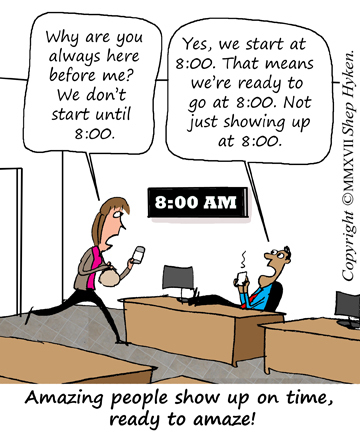 This week is National Customer Service Week. To help celebrate, I’m offering a free Amazon eBook of Be Amazing or Go Home (Available from Amazon). The article below is an example of one of the habits taught in the book. Happy Customer Service Week!
This week is National Customer Service Week. To help celebrate, I’m offering a free Amazon eBook of Be Amazing or Go Home (Available from Amazon). The article below is an example of one of the habits taught in the book. Happy Customer Service Week!
One day my assistant came in late. Not a big deal. That was until she came in late two more times that week. The following week the same thing happened again. This was becoming a habit – and not a good one.
So, we had a short talk about it. I asked her what our mantra was at Shepard Presentations. She said, “To be amazing.” She was right.
So, I asked her, “Is showing up late three or four times a week amazing behavior?”
She gave me the obvious answer, “No.”
I replied, “I agree. This is a habit that must stop. So, you have a choice. Be amazing or go home.”
She smiled and said, “That’s a great title for a book! You better write that down.”
I did, and guess what? It became a book, officially titled, Be Amazing or Go Home: Seven Customer Service Habits that Create Confidence with Everyone.
You see, if showing up late is a bad habit, then showing up early is a good habit. Delivering good customer service is a habit. You know what’s right. You practice it day after day on real customers. You get better at it. You may even get special customer service training. And, when it becomes natural, it’s like many other good things you do over and over. It becomes a habit.
When I was just twelve years old I started my own business; doing magic shows for children’s birthday parties. There were several important habits I picked up from my parents. I wrote thank you notes to the parents that hired me to perform for their child’s party. I always showed up on time. I always did the best job I could, never giving less than 100%. I always stayed a little longer than expected, and the parents really appreciated that. I had to consciously think about doing all of that and more until I did it enough times that it became natural. It became my version of common sense. That’s what makes it a habit.
Those habits as a twelve-year-old magician stayed with me. Today, these habits drive my business. I’ve shared with you a story about my assistant. That’s the first lesson in the book. It’s simply this:
Amazing people show up ready to amaze!
What that means is if the office opens at 8:00. Showing up at 8:00 isn’t really showing up on time. It’s getting there on time. Showing up on time, ready to amaze, is arriving early enough to be ready to go at 8:00. There’s a difference.
By the way, my assistant broke the bad habit and started showing up to work on time. She chose not to go home. She chose to be amazing!
Shep Hyken is a customer service expert, keynote speaker and New York Times bestselling business author. For information contact or www.hyken.com. For information on The Customer Focus™ customer service training programs go to www.thecustomerfocus.com. Follow on Twitter: @Hyken
(Copyright © MMXVII, Shep Hyken)
The post Customer Service Is a Habit (So Is Bad Customer Service) appeared first on Shep Hyken.
October 3, 2017
Amazing Business Radio: Doug Bell
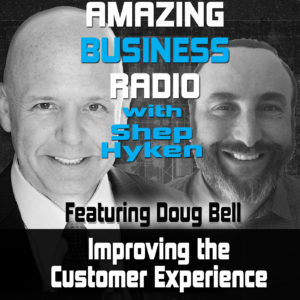
Doug Bell Discusses Improving the Customer Experience
Would you like every employee to know how they fit into your company’s customer experience?
Shep Hyken interviews Doug Bell, founder of The Experience Manager, a system that helps manage and unify the entire customer experience.
Featured Interview:
Shep and Doug discuss the importance of unifying the customer experience throughout an entire company. Every employee must understand how they fit into the customer’s journey.
Top Takeaways:
Decide how your company wants to interact with your market. What do you want your customers to experience when they do business with you? Whatever the answer, it must be packed into every touchpoint the customer has with your company. This is the beginning of “experience management.”
The true problem with managing the customer experience comes when employees don’t understand how they fit into the overall customer experience.
The customer experience must be evaluated and managed EVERY DAY. You should always ask yourself, “What can we learn from today’s experience that can make tomorrow’s even better?”
The best way to change the way a company manages its customer experience starts with unifying your customer experience vision throughout the entire company.
About:
Doug Bell is a CX consultant and the founder of The Experience Manager, a platform that allows companies to build their customer journey map, and in turn, keep ALL customer interactions that your company is managing known to across all departments.
Shep Hyken is a customer service and experience expert , “New York Times” best-selling author, award-winning keynote speaker , and your host of Amazing Business Radio.
“The customer experience predicts your company’s future.” – Doug Bell
This episode of Amazing Business Radio with Shep Hyken answers the following questions … and more:
How can I unify my customer experience throughout my company?
What predicts a company’s success?
How do I manage the customer experience?
What can I do to improve the customer experience?
The post Amazing Business Radio: Doug Bell appeared first on Shep Hyken.
October 2, 2017
5 Top Customer Service Articles for the Week of October 2, 2017
Each week I read a number of customer service articles from various online resources. Here are my top five picks from last week. I have added my comment about each article and would like to hear what you think too.
How to Become a More Customer Centric Business in 5 Steps by Mark Sallows
(FitSmallBusiness) Customer centric businesses invest the whole team focus on supporting their prospective and existing customers. This doesn’t just mean sales and customer service, but accounting, marketing and other departments as well. Customer centric sales requires a more consultative approach, and sometimes means prioritizing help and advice over tying to make a speedy sale.
My Comment: The term customer-centricity has become very popular over the last few years. My basic definition is that every decision and process a company makes and has keeps the customer in mind. This article has some great information. Some of it is a reinforcement of what you might know, but it’s worth reading. I’m surprised how many companies don’t create a detailed journey map to dig deep into each (and every) interaction that customers have with you. So pay close attention to number two.
‘Woo, Wow, and Win’: Designing a Captivating Customer Experience by Knowledge@Wharton
(The Wharton School) Companies carefully craft the products they sell to customers, but rarely do they give the same thoughtfulness to designing what could be the most critical part of the sales process: customer experience.
My Comment: Thomas A. Steward and Patricia O’Connell have written a great book, “Woo, Wow and Win: Designing a Captivating Customer Experience.” Who doesn’t want to deliver an experience that is captivating and makes customers want to come back?! This is actually the transcribed interview from a Wharton University podcast. (So you know it must be good!) Your choice. You can read it or listen to it.
The Most Important Rule of Journey Mapping by Annette Franz
(Effectly) Creating a customer journey map is an important first step when it comes to your customer experience transformation.
My Comment: Our first article recommended in this week’s Top Five roundup had to do with creating customer centricity. I mentioned that step two of that process had to do with creating a customer journey map. This short article by Annette Franz, who is the guru in journey mapping, breaks the process of designing the map into four very simple and concise steps. (Remember, simple does not always mean easy.) If you haven’t yet created the journey map, it’s time to do so!
Want to transform customer service? Question conventional wisdom! by Anand Subramaniam
(CustomerThink) 1838. It was the year that the term “conventional wisdom” (CW) was first used in print. Over the decades, CW has prevented or stalled progress in many domains, and customer service is no exception. Here are some common beliefs about customer service that you are well-advised to question and perhaps jettison.
My Comment: The author shares some customer service and CX “conventional wisdom” and then shares commentary on why we should question it. Great concepts here. What you believe to be true may be holding you back. Conventional wisdom thwarts progress and innovation – in everything, including customer service!
How chatbots could change customer service over the next 5 years by Becky Peterson
(Business Insider) As more companies come to embrace chat functions to complement or reduce human phone centers, rudimentary human-to-human chat conversations will soon be a thing of the past, according to experts in the field. In the next three to five years alone, chatbots will become nearly ubiquitous, and work seamlessly with human customer support agents to provide customers with efficient, personalized responses.
My Comment: What will the future of customer service look like? Today we’re getting a glimpse of the future. Chatbots, fueled by AI (Artificial Intelligence) will be normal in customer service. The article claims that support centers (with humans) may become a thing of the past. On that point, I disagree. There is a reference that chatbots won’t replace humans altogether. I think there is more job security in this area than many think. Chatbots will get “smarter” over time. The ability to get questions answered and problems resolved in the quickest, simplest and with the least amount of friction is the goal of the forward-thinking company. This article gives some insight into what that will look like.
Shep Hyken is a customer serv ice expert, professional speaker and New York Times bestselling business author. For information contact (314)692-2200 or www.hyken.com . For information on The Customer Focus™ customer service training programs go to www.thecustomerfocus.com . Follow on Twitter: @Hyken
The post 5 Top Customer Service Articles for the Week of October 2, 2017 appeared first on Shep Hyken.
September 29, 2017
Guest Blog: The Science of Business
This week we feature an article by Doug Bell who writes about how leaders can optimize their company’s customer experience. It is important to have a plan in place for managing the customer experience and having a customer-focused culture. – Shep Hyken
A Simple Playbook for Managing Customer Experience
Every team inside a company impacts the customer experience. Each of these teams is in constant motion to manage the customer interactions for which they are responsible. But when a team makes changes to their plan, how do their changes impact the overall experience? The coordination required between teams is a major challenge. The challenge becomes much greater when teams are dispersed across geographies and the world is changing faster every day. On top of this, there are new team members joining, and existing team members unplugging and plugging back in all the time.
Here is a step-by-step playbook for leaders to optimize their company’s customer experience:
STEP #1: Create a simple experience plan by answering three questions
Who is the customer for your experience?
The first step is to make sure everyone on the team knows exactly who your customers are. Don’t take anything for granted. Unify your team around how you define your customer.
What is the goal of the experience?
Experience management is no different from any other type of management. Start by defining the result. Paint a clear picture of what you want the outcome of your experience to be. The easiest outcomes to measure are based on customer behaviors. It’s easy to track repeat purchases, referrals, feedback and other behaviors that your company can observe. If your goal is simple, it will be easier to focus your team on producing that outcome.
What are the key interactions that need to be managed?
Your customer’s experience is their story of interacting with your company. From the first moment they learn about your solution, each interaction shapes their perceptions and drives their future behaviors. An amazing interaction – or magic moment – can seed thousands or millions of future sales. The first step in creating magic moments is identifying the opportunities you have to create them – your interactions. Start with the interactions that you recognize as mission-critical to your operation: marketing, customer service, sales, service delivery, product features, etc. Over time, you can add or subtract interactions as your experience design evolves. The key is to have a clear, top-level vision for how your company plans to interact with your customer.
STEP #2: Name your experience leaders
Identify the individual that is responsible for the success of the experience
Every operation has a leader and so should every experience. Select one person that will be responsible for coordinating efforts across departments to optimize the experience for the customer AND the company. It is the experience leader’s responsibility to align the experience with the goals and overall mission of the company.
Identify the individual that is responsible for the success of each interaction
The experience leader should then assign responsibility for each interaction to individuals they trust. With every interaction assigned, the team will be focused on 100% of the customer experience.
STEP #3: Measure the experience outcomes
Measure the outcome of the experience.
Observe the customer behaviors resulting from your experience. Are customers coming back? Are they referring others? Are you getting positive feedback? Whatever your experience goal is, observe whether or not you are achieving it and track your success rate.
Measure the outcome of each interaction.
Observe the customer behaviors resulting from each interaction they have with their experience. Are customers engaging further or pulling back? In which interactions are your company building relationships and in which interactions are you not? Optimize your interactions and you’ll optimize your customer’s experience.
STEP #4: Improve the experience outcomes
Make it easy for team members to share ideas and success stories with the people responsible for the experience
At a very minimum, create a dedicated email address for ideas. You can create incentives for the ‘idea of the day’. Be creative in engaging every member of your team to share their perspectives and ideas to improve. You never know who that next game-changing idea is going to come from.
Create a system for implementing the best ideas and making improvements
Approve the best ideas you receive. Create a plan to initiate the change. Show your team that you won’t let a good idea go to waste. How fast can you turn their amazing ideas into improvements in your experience?
Provide a channel for communicating experience changes
For the front line team responsible for producing the experience, it’s necessary for everyone to be on the same page. A dedicated communication channel for experience will enable you to make changes in real time.
Now share the plan with every member of your experience team. In addition to changing the paradigm for experience in your industry, you will have a new way to effectively measure employee engagement and performance, find out who your experience leaders are, and turn everyone on your team into idea generators and experience producers.
Doug Bell is the CEO of The Experience Manager which helps companies unify their customer experience approach. For more on implementing this experience management process into your business and other valuable insights visit www.theexperiencemanager.com or contact Doug directly at theexperiencemanager.com.
For more articles from Shep Hyken and his guest contributors go to customerserviceblog.com.
Read Shep’s latest Forbes Article: National Customer Service Week Is Approaching — How Will You Celebrate?
The post Guest Blog: The Science of Business appeared first on Shep Hyken.
September 27, 2017
Your Brand is Only as Strong as Your Weakest Link
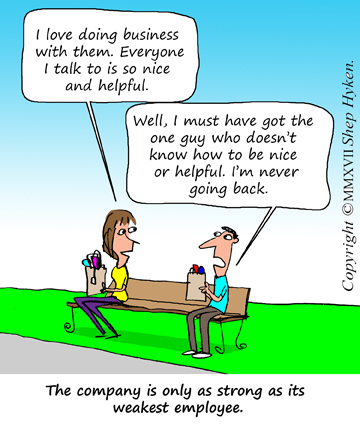 So, the other day I’m flying to a speaking engagement. While waiting for my flight to board I bought a yogurt parfait. After paying for it, I looked for a spoon. There were knives and forks, but no spoons. The little compartment next to the knives and forks was empty. I asked the cashier if they had any spoons. He pointed to where they weren’t. I told him they were out, and in an effort to get rid of me, he suggested that I could go to the restaurant next store and ask them for a spoon.
So, the other day I’m flying to a speaking engagement. While waiting for my flight to board I bought a yogurt parfait. After paying for it, I looked for a spoon. There were knives and forks, but no spoons. The little compartment next to the knives and forks was empty. I asked the cashier if they had any spoons. He pointed to where they weren’t. I told him they were out, and in an effort to get rid of me, he suggested that I could go to the restaurant next store and ask them for a spoon.
I walked by the first restaurant a few minutes later and there were plenty of spoons. Obviously, there were spoons somewhere. The guy just didn’t want to get them, when a customer needed them.
I didn’t want to make a scene over this, but I thought I’d mention something to the manager. He wasn’t there when I bought my yogurt. He apologized, but then said something interesting. He mentioned that the restaurant was managed by a group at the airport, so I really shouldn’t expect the same service or quality I am accustomed to at this company’s regular restaurants.
This was a major brand with locations throughout the US. The airport restaurant had the same signage, the same logo and looked just like any of the restaurants you would visit outside of the airport. I’m sure that any executive of this brand would cringe at the response the manager gave me… “I really shouldn’t expect the same service or quality I’m accustomed to…” Really?!
And, that is where our lesson begins. You see, it doesn’t matter if it is an airport restaurant, a small kiosk or a full-service restaurant. There must be a similar experience across all locations, regardless of size or where it is. The logo is the logo, and the brand is the brand!
Let’s switch industries and talk about an icon in the world of customer service. When Nordstrom decided to move into the online world, many of their customers were concerned that they would erode their reputation for amazing service. Management thought long and hard about how to create an online experience that matched the expectation of a Nordstrom customer, and they delivered. Regardless of location – instore or online – Nordstrom will always focus on making sure the customer has the best experience.
Now we move to an employee within a company. If there are 100 employees, and 99 of them are amazing, but one is not, what happens when a customer encounters the one who is not? You know the answer. That one bad employee just created the reputation for your brand – at least with that customer.
The old saying is that a chain is only as strong as its weakest link. Well, the brand is only as strong as its weakest location – or weakest employee.
Shep Hyken is a customer service expert, keynote speaker and New York Times bestselling business author. For information contact or www.hyken.com. For information on The Customer Focus™ customer service training programs go to www.thecustomerfocus.com. Follow on Twitter: @Hyken
(Copyright © MMXVII, Shep Hyken)
The post Your Brand is Only as Strong as Your Weakest Link appeared first on Shep Hyken.
September 26, 2017
Amazing Business Radio: Robert Spector
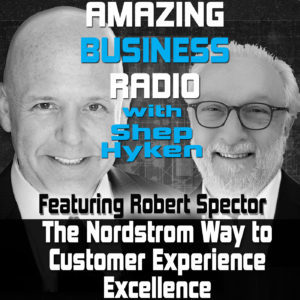
Robert Spector Shares The Nordstrom Way to Customer Experience Excellence
How would you like to be the Nordstrom of your industry? Well stay tuned and you’ll learn tips to help you do just that!
Shep Hyken interviews Robert Spector, author of The Nordstrom Way to Customer Experience Excellence: Creating a Values-Driven Service Culture.
Featured Interview:
Shep and Robert discuss the impact Nordstrom’s values and culture have on their customer and employee experience. Robert shares a bit about the history of Nordstrom – like the facts they have been around 116 years – they’ve survived two world wars, made it through The Great Depression, and more. Nordstrom sets a standard above the rest by making trust their number one value and by constantly innovating and adapting to the changing consumer buying habits. This is all about customer service and creating a customer focused culture that makes customers want to come back again and again!
Top Takeaways:
Don’t try to convince employees to share your core values – you want to attract employees who already instill your core values.
Trust – it is the basis for all relationships. Nordstrom demonstrates how it trusts it’s employees through their unique employee handbook which is on a 5 by 7 card that reads on one side, “Welcome to Nordstrom we’re glad to have you with our company, we have only one rule…” Turn it over to reveal that one rule, “Use good judgment in all situations.”
Three Incredible Truths
Most people want to do a good job.
Most people want to feel a part of something bigger than themselves.
It’s up to management to make that happen.
Innovation and Adaptation – Nordstrom has been around so long due to its ability to innovate and adapt. They started as a shoe store. They moved into selling clothing and accessories. They moved from just the big store anchoring a mall to the addition of Nordstrom Rack, an online presence and several forward-thinking concepts. And throughout all of this they never lost sight of the importance of the customer. Everything is about the customer!
Define and live your values – If you want to instill a culture of employee and customer focus, you have to identify your values and then hire, attract, and coach to those values – that’s how you become the Nordstrom of your industry (and you have to emphasize that every day).
About:
Robert Spector is and author, teacher, co-founder of RSI consultancy and the co-author of The Nordstrom Way to Customer Experience Excellence: Creating a Values-Driven Service Culture.
Shep Hyken is a customer service and experience expert , “New York Times” best-selling author, award-winning keynote speaker, and your host of Amazing Business Radio.
“If it’s not helping the customer, it’s not customer service.” – Robert Spector
This episode of Amazing Business Radio with Shep Hyken answers the following questions … and more:
How can I create a better customer experience?
How can I be more like Nordstrom?
How can I deliver customer service like Nordstrom?
How do I hire right?
What can I do to create a better service experience?
How can I create a customer-focused culture?
The post Amazing Business Radio: Robert Spector appeared first on Shep Hyken.








